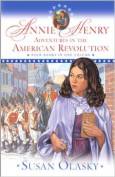
I first learned about Patrick Henry’s special letter to his daughter Annie from this book by Susan Olasky.
On March 23, 1775 Patrick Henry delivered his “Give Me Liberty or Give Me Death” speech before the House of Burgesses. His words still echo down the halls of history. With that in mind, he’s the focus of today’s Snail-Mail Saturday post! However, I decided to give you a glimpse of him that you may not be familiar with – just as I wasn’t until several years ago.
Below are excerpts from a letter Patrick Henry penned to his daughter Annie on the occasion of her wedding in 1786. I did my best (with the time I had) to find an accurate copy. (I found several that differed slightly.) At any rate, the advice Patrick Henry shares seems like a good reminder for all of us, whether married or not. And perhaps this letter will paint you a picture of Patrick Henry as not only a Christian statesman and the “Trumpet of the Revolution” but also as a loving Christian father.
My Dear Daughter
You have just entered into that state which is replete with happiness or misery. …
You are allied to a man of honor, of talents, and of an open, generous disposition. You have, therefore, in your power all the essential ingredients of happiness: it cannot be marred, if you now reflect upon that system of conduct which you ought invariably to pursue – if you will now see clearly the path from which you will resolve never to deviate. …
The first maxim which you should impress upon your mind is never to control your husband, by opposition, by displeasure, or any other work of anger. … Little things that in reality are mere trifles in themselves often produce bickering and even quarrels. Never permit them to be a subject of dispute; yield them with pleasure, with a smile of affection. …
Cultivate your mind by the perusal of those books which instruct while they amuse. Do not devote much of your time to novels. … History, geography, poetry, moral essays, biography, travels, sermons, and other well-written religious productions, will not fail to enlarge your understanding, to render you a more agreeable companion, and to exalt your virtue. A woman devoid of rational ideas of religion, has no security for her virtues; it is sacrificed to her passions, whose voice, not that of God, is her only governing principle. Besides, in those hours of calamity to which families must be exposed, where will she find support, if it be not in the just reflections upon that all-ruling Providence which governs the universe, whether inanimate or animate?
Mutual politeness between the most intimate friends is essential to that harmony which should never be broken or interrupted. How important, then, it is between man and wife! … I will only add, that matrimonial happiness does not depend on wealth; no, it is not to be found in wealth; but in minds properly tempered and united to our respective situations. Competency is necessary. All beyond that is ideal. Do not suppose, however, that I would not advise your husband to augment his property by all honest and commendable means. …
In the management of your domestic concerns, let prudence and wise economy prevail. Let neatness, order and judgment be seen in all your different departments. Unite liberality with a just frugality; always reserve something for the hand of charity; and never let your door be closed to the voice of suffering humanity. Your servants, in particular, will have the strongest claim upon your charity; let them be well fed, well clothed, nursed when in sickness, and let them never be unjustly treated.
Isn’t it interesting to peek into life during America’s early days? I especially like getting to know people of the past through their own words. You can read the letter in its entirety here on GoogleBooks, Patrick Henry: Life, Correspondence and Speeches Vol. 2 by William Wirt Henry, 1891. See Chapter XXXIV, pg. 305-309. Newer republished editions are also available on Amazon.

